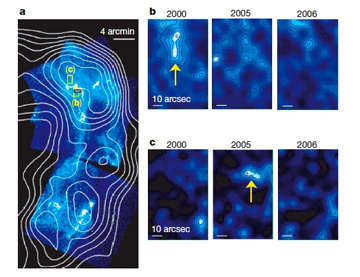Topics List
Oct. 20, 2015 Updated
Suzaku reveals average chemical composition of our Universe on largest scales
|
All of the chemical elements that are heavier than carbon, the oxygen we breathe, the silicon that makes up the sand on the beach, were produced inside stars through nuclear fusion and released by stellar explosions called supernovae. By measuring the chemical composition of the Universe, scientists are trying to reconstruct the history of how, when, and where each of the chemical elements so necessary for the evolution of life were produced. |
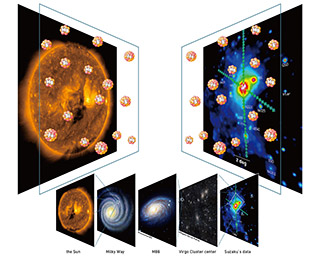
|
|---|
Aug. 26, 2015 Updated
Suzaku completes its scientific observations
|
JAXA determined that it is difficult to resume scientific
observations of the X-ray Astronomy Satellite “Suzaku”, whose
communication functions have been intermittently failing since June 1,
2015, despite our efforts to restore the regular operation. The decision
to complete the observations was made after carefully examining the
conditions of not only communication, but also batteries and attitude
control. |

|
|---|
Jun. 12, 2015 Updated
Hopes to recover normal operation after Suzaku communication failure
|
The X-ray Astronomy Satellite “Suzaku” (ASTRO-EII) continues its
operation after exceeding its target life of about two years. However,
since June1, 2015, communication with the Suzaku has been intermittently
cut off, so that we can confirm its operational status only when
communication is established. We now assume that insufficient power is
causing the discontinued communication. Thus we are doing our best to
gather more accurate information of the operational status based on
accumulated data through sporadic communication. |
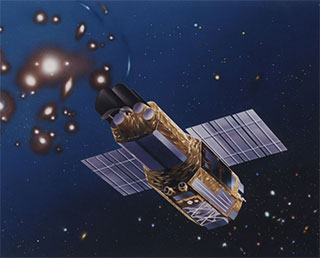
|
|---|
Mar. 27, 2015 Updated
Galaxy Scale Outflow of Matter Stimulated by a Monster Black-hole
|
By the observations from the Japan-led Suzaku X-ray satellite adn the European Space Agency’s infrared Herschel Space Observatory, scientists have discovered the first proof that a fierce outward “wind” is produced when a huge black-hole consumes a large mass of material, and the wind is source of outflow of matter at the galaxy scale.
|
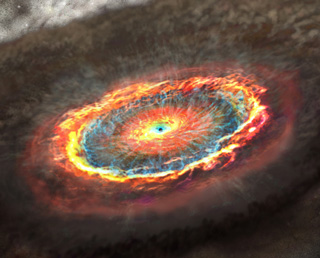
|
|---|
Jan. 10, 2014 Updated
Instantaneous heater in space
|
A research group led by Researcher Hiroya Yamaguchi at the NASA Goddard
Space Center captured, for the first time in the world, proof of
instantaneous electron heating to about 200 million degrees Celsius by
shock waves of“Tycho Brahe's Supernova remnant” generated by an
explosion 422 years ago. |

|
|---|
Oct. 31, 2013 Updated
Suzaku clarifies explosive period of heavy elements for first time
|
Researchers from Stanford University and JAXA elucidated through the observation by the X-ray Astronomy Satellite “Suzaku” that there was a period about 10 billion years ago when heavy elements including iron were spread throughout the universe, and it was confirmed that those spread elements during that explosive period are the origin of most heavy elements currently existing in the universe. |
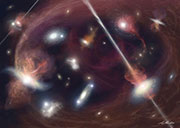
|
|---|
Mar. 23, 2012 Updated
Japan's all-out effort to find cannibalistic "poisonous spider" neutron
|
A joint research group of the Tokyo Institute of Technology and Waseda University has conducted observations to elucidate the mysterious gamma-ray source “2FGLJ2339.6-0532,” which was found by the gamma-ray astronomical satellite "Fermi." For the observations, JAXA's X-ray astronomy satellite "Suzaku" and the Optical and Infrared Synergetic Telescopes for Education and Research (OISTER), a global network of telescopes, were fully utilized. |
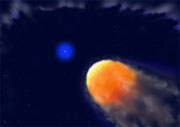 |
|---|
Mar. 25, 2011 Updated
Suzaku elucidates the outskirts of the cluster of galaxies
|
Thanks to the X-ray Astronomy Satellite "Suzaku," which has been observing the Perseus Galaxy Cluster and studying its size, mass and chemical contents in detail, we have acquired proof that million-degree gas clouds in a large volume are tightly gathered in the cluster's outskirts. |
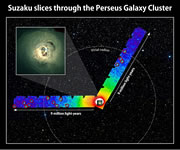 |
|---|
Jan. 17, 2011 Updated
AKARI and Suzaku confirm dust generation due to supernova burst
|
The Infrared Imaging Satellite "AKARI" and the X-ray Astronomy Satellite "Suzaku" have been observing remnants of a supernova commonly known as Tycho's supernova. |
 |
|---|
May 7, 2010 Updated
Suzaku thesis receives PASJ English thesis award
|
The research achievement thesis titled “Evidence for Solar-Wind Charge-Exchange X-ray Emission from the Earth’s Magnetosheath” received the 15th Publications of the Astronomical Society of Japan (PASJ) English thesis Award. The research has been carried out by a group led by Associate Professor Ryuichi Fujimoto, Astrophysics Laboratory, Institute of Science and Engineering, Faculty of Mathematics and Physics, Kanazawa University. Through this research, it was clarified that an unknown changing X-ray source found in the soft X-ray region in the 1990s was solar wind. |
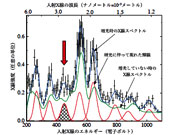 |
|---|
Apr. 12, 2010 Updated
Suzaku witnessed the growing scene of the largest structure in space
|
The research group of the RIKEN Advanced Science Institute and the Academia Sinica Institute of Astronomy and Astrophysics led by researcher Madoka Kawaharada of the Cosmic Radiation Laboratory, RIKEN, (currently belonging to ISAS/JAXA) observed the galaxy cluster A1689, 2.4 billion light-years away from the Earth, using the Suzaku, and successfully captured footage showing that the A1689 was growing while reacting with the large-scale structure existing outside the galaxy cluster. This observation is expected to lead to more understanding about the dynamic growth of space through further logical analysis and comparisons with simulations. |
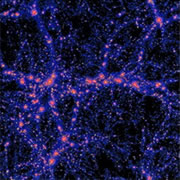 |
|---|
Jan. 26, 2010 Updated
Suzaku data helps find major hard X-ray emissions around Jupiter
|
A group of researchers led by Assistant Professor Yuichiro Ezoe of the Graduate School of Science and Engineering, Tokyo Metropolitan University, found hard X-ray emissions spreading around Jupiter based on observation data acquired by the X-ray Astronomy Satellite "Suzaku." |
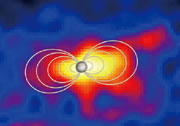 |
|---|
Dec. 14, 2009 Updated
Suzaku clarified new remnant of a supernova
|
RIKEN, Kyoto University and Tokyo Metropolitan University took X-ray images of the Jerry Fish Nebula of Gemini (the remnant of a supernova that exploded about 4,000 years ago) using the X-ray Astronomy Satellite "Suzaku." Through shooting this image, the researchers captured proof that the nebula was a gigantic fireball that was 10,000 times hotter than the sun just after its explosion. It was the first time in the world to capture such evidence. |
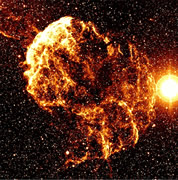 |
|---|
Nov. 2, 2009 Updated
Suzaku discovered a large amount of rare metals outside the Galaxy
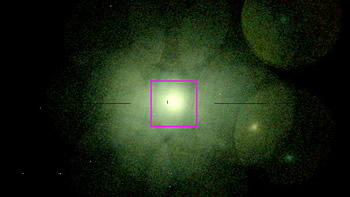 |
|---|
Jul. 15, 2009 Updated
Marking 4 years since the launch of "Suzaku"! A report on the latest achievements
|
"Suzaku" (ASTRO-EII) marked its 4th anniversary on July 10th, 2009, and is still observing various X-ray celestial objects, bringing us new discoveries every day. |
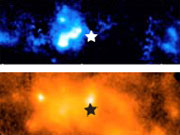 |
|---|
Nov. 4, 2008 Updated
Suzaku confirmed highest-level of hot gas in space 5 billion light-years away from Earth
|
The "Suzaku" observed the cluster of galaxies RXJ1347, about 5 billion light-years away from Earth, and found the largest collection of high-temperature gas, of some 300 million degrees, in the cluster. This proves that galaxies collide at high speed, combine into one, and violently heat up. This observation helped us understand the process of a cluster of galaxies to a larger heavenly body. |
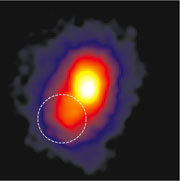 |
|---|
Sep. 11, 2008 Updated
Suzaku: Rare metal generation observed for first time in space
|
A research group led by Researcher Toru Tamagawa of the RIKEN institute carefully observed the remnant of the supernova Tycho using our satellite "Suzaku" and found that chromium and manganese were generated there. This is the first time to identify the actual generation scene. Chromium and manganese are believed to be the most important chemical elements to learn the explosion mechanism of a star because their generation scenes are very sensitive to temperature and physical density. The finding this time suggests that a shock wave plays a role in the burning of a supernova explosion. |
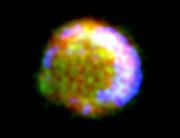 |
|---|
Apr. 17, 2008 Updated
Black Hole in the central Milky Way Galaxy awaken 300 years ago
|
After compiling the observation results from the Japanese X-ray Astronomy Satellites "Asuka" and "Suzaku", and NASA's Chandra X-Ray Observatory, and the European Astronomical Society's (EAS's) XMM-Newton X-ray Observatory, a Japanese research team concluded that the Black Hole in the central Milky Way Galaxy experienced the Big Bang approximately 300 years ago. |
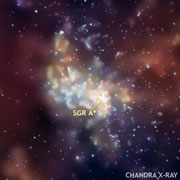 |
|---|
Jan. 17, 2008 Updated
Suzaku: White Dwarf Pulsar found
|
From observation data acquired by the X-ray observatory “Suzaku,” a research group led by Assistant Professor Terada of Saitama University found that high-energy X-rays emitted from the “AE Aquarii,” a binary star system consisting of a white dwarf and an ordinary star, synchronized with the rotation of the white dwarf, and the hard X-ray pulses match the spin period of 33 seconds. |
 |
|---|
Oct. 4, 2007 Updated
Witnessing shock-acceleration of cosmic rays
Aug. 28, 2007 Updated
New method for probing exotic matter
|
Using Japanese/NASA and European X-ray satellites, astronomers have seen Einstein's predicted distortion of space-time around three neutron stars, and in doing so they have pioneered a groundbreaking technique for determining the properties of these ultradense objects. |
 |
|---|
Jul. 31, 2007 Updated
Suzaku unveiled a new type of active galaxy
|
An international team of astronomers using Suzaku observatory and Swift satellite has discovered a new class of active galactic nuclei (AGN). |
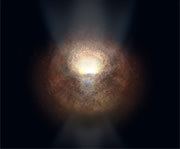 |
|---|
Aug. 18, 2005 Updated
Suzaku successfully took a photo of the wreckage of a supernova, the "Small Magellan Cloud (SMC)"
|
The X-ray astronomy satellite Suzaku, which was launched on July 10, successfully observed and took X-ray images of the wreckage of a supernova (the signs of a star explosion) in the Small Magellan Cloud (SMC) by opening the covers of four onboard X-ray CCD cameras (XIS) during the operation between the evenings of Aug. 12 and Aug.13. Lighting streaks seen in the energy zone observed by the Suzaku are emission from nitrogen and oxygen, thus we have high expectations for new findings on the generation and evolution of these elements, which are the base of life, in space. |
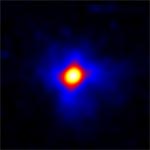 |
|---|
Jul. 29, 2005 Updated
Cryogenic world record of 60 mK (milli-Kelvin) in space set
At around 1:15 a.m. on July 27 (Japan Standard Time), we confirmed that the X-ray spectrometer, (XRS), which is installed in the Suzaku, achieved 60 mK (Kelvin is a unit of absolute temperature.) The XRS is operating normally.
The record of 60 mK, which was achieved by operating the adiabatic demagnetization cooling machine of the XRS, is a cryogenic temperature equivalent to 273.09 degrees Celsius, and the world record for the lowest artificially made temperature in space. This achievement confirms the Suzaku's high performance in X-ray observations.
The Suzaku team is working for "first light" scheduled in mid August.
Jul. 21, 2005 Updated
Operation Status of the "Suzaku"
|
The 23rd scientific satellite Suzaku (ASTRO-EII) is operating smoothly. Japan Aerospace Exploration Agency launched the Suzaku at 12:30 p.m. (Japan Standard Time, JST) on July 10, 2005, from the Uchinoura Space Center. |
 |
|---|
Jul. 10, 2005 Updated
M-V-6/ASTRO-EII successfully launched
The satellite nickname is "Suzaku"
|
The M-V Launch Vehicle No. 6 (M-V-6) with the 23rd scientific satellite (ASTRO-EII) onboard was successfully launched at 12:30 p.m. on July 10, 2005 (Japan Standard Time, JST) from the Uchinoura Space Center (USC). The launch vehicle flew smoothly, and it was confirmed that the satellite was injected into the scheduled orbit. |
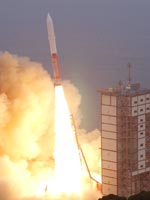 |
|---|
May 26, 2005 Updated
A final spurt before launch
|
The ASTRO-EII satellite is in the final phase before its launch from the Uchinoura Space Center, located in the Osumi Peninsula in east Kagoshima. The satellite left Sagamihara Campus, where it was developed, in mid May, stopped by at the Tsukuba Space Center, and is expected to arrive at the Uchinoura Space Center on May 26. The satellite team are gradually making their way to Uchinoura with the satellite to carry out launch site operations for the launch scheduled on June 26. |
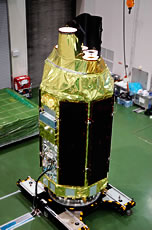 |
|---|
Jul. 30, 2004 Updated
Last test commences before launch
|
Astro-E2, an astronomy satellite using X-ray, is undergoing a final "integration test" for its launch scheduled for next year. Over nine months from April, the satellite is being put through the assembly process, operational verification in vacuum after the assembly, and vibration and shock tests by simulating a launch. |
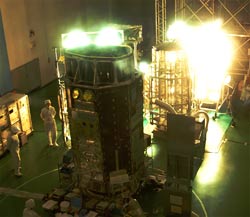 |
|---|
Dec. 19, 2003 Updated
The first interface verification was completed.
|
The first interface verification of the ASTRO-EII since July 1, 2003 was successfully completed. Many researchers for this international collaborative scientific mission participated in the verification. |
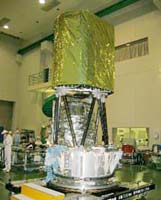 |
|---|
